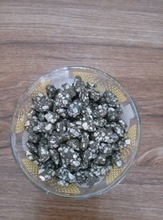Manufacturer Supply Calcium Bentoite/ Sodium Bentonite With Good Quality
Sodium bentonite expands when wet, absorbing as much as several times its dry mass in water.Because of its excellent colloidal properties, it is often used in drilling mud for oil and gas wells and boreholes for geotechnical and environmental investigations.The property of swelling also makes sodium bentonite useful as a sealant, since it provides a self-sealing, low permeability barrier. It is used to line the base of landfills for example.
Various surface modifications to sodium bentonite improve some rheological or sealing performance in geoenvironmental applications, for example, the addition of polymers.
Fields of Use:
Drilling:
Drilling mud, or drilling gel, is a major component in the well drilling process. Drilling mud is crucial in the extraction of drill cuttings during the drilling process. Bentonite, when mixed with water, forms a fluid (or slurry) that is pumped through the drill stem, and out through the drill bit. The bentonite extracts the drill cuttings from around the bit, which are then floated to the surface. The drilling mud, or gel, also serves to cool and lubricate the drill bit as well as seal the drill hole against seepage and to prevent wall cave-ins.
Taconite Pelletizing:
Taconite, a low grade iron ore, has been developed as an economic source for iron. During processing, the taconite is ground into a very fine powder. The ground taconite is then mixed with small amounts of bentonite which serves as a binder to the taconite. This mixture is processed into balls or pellets. The process is finished when these pellets are sintered in rotary kilns that give the pellets a hard surface. The taconite pellets are easy to handle at this point and can be loaded into various containers for shipment to steel mills.
Metal Casting:
Bentonite serves as an economical bonding material in the molding processes associated with the metal casting industry. Bentonite, when mixed with foundry molding sands, forms a pliable bond with the sand granules. Impressions are formed into the face of the bentonite/sand mixtures. Molten metal is pored into the impressions at temperatures exceeding 2,800 F. The unique bonding characteristics of bentonite insures the durability of the mold during these high temperatures. Once the process is complete, the bentonite/sand mold can then be broken away from the casting face and reused.
Cat Litter:
In recent years, bentonite has become a major component in the manufacturing of cat litter. Because of the unique water absorption, swelling, and odor controlling characteristics of bentonite, it is ideal for use in "clumping" types of cat litters.Clumping cat litter has become widely accepted as an economical alternative to conventional non-clumping type cat litters. Because bentonite forms clumps when wet, the clumps can easily be removed and disposed of. The remainder of the unused material stays intact and can continue to be used. clumping cat box litters will last longer with less frequency of changing.

























 在线聊天
在线聊天


























